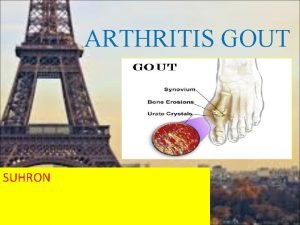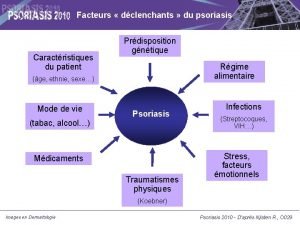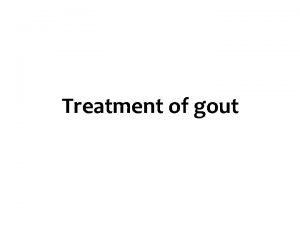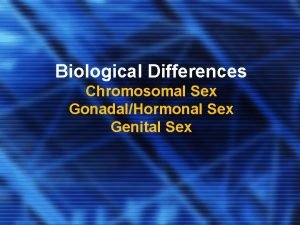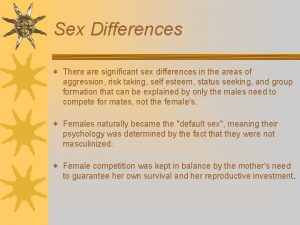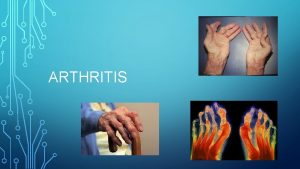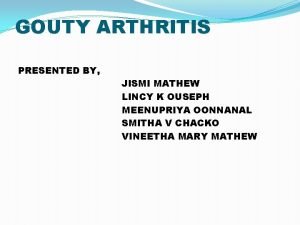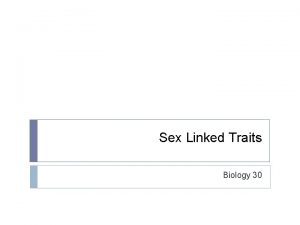Sex Differences in Gouty Arthritis Gouty arthritis is

























- Slides: 25

Sex Differences in Gouty Arthritis

Ø Gouty arthritis is a disease caused by the inflammatory response to monosodium urate crystals that have deposited in joints. 1 Ø Gouty arthritis is often perceived as a disease in males, but the prevalence of gout in females is significant and on the rise. 2, 3 Ø Though there are many similarities between gout in males and females, there also significant differences in the pathophysiology, epidemiology, clinical manifestations, and treatment. Ø Increased awareness of these differences will lead to better recognition, management, and outcomes for women with gout. Introduction

Physiology

Uric acid is produced in the body through the degradation of purines by xanthine oxidase. 1 Ø A balance between uric acid production and excretion is what determines serum uric acid levels in humans. 1 Ø Average serum uric acid levels are lower in women then in men, especially before menopause. 2, 3 Physiology It then dissolves in the blood and exists primarily as the urate anion. 1 Urate is then transported in the blood to the GI tract and kidneys where it is excreted. 1

Ø Urate is freely filtered by the kidney and also secreted in the proximal tubule. 1 Ø It is then subjected to significant reabsorption in the proximal tubule by various transporters. 1 Ø URAT 1 and GLUT 9 have been identified as important transporters for urate reabsorption. 1, 2 Physiology 17β-estradiol has been shown to downregulate GLUT 9 transporters which may help explain sex differences in serum urate levels and gout prevalence. 3 Genetic variants of the gene SLC 2 A 9 which codes for the GLUT 9 transporter are associated with lower serum uric acid levels, and the association is even more pronounced in women. 4, 5

Pathology

Hyperuricemia Ø Gouty arthritis occurs when urate precipitates into monosodium urate (MSU) crystals that deposit in joints. 1 Ø These crystals elicit an inflammatory response that leads to the clinical manifestations of gout. 1 Pathology Precipitation and deposition of monosodium urate crystals in joints Acute/chronic inflammatory response to crystal deposition Gouty arthritis

Ø Hyperuricemia is required for the precipitation of MSU crystals. 1 Ø However, nucleation and growth of MSU crystals is a complex process influenced by other factors besides just hyperuricemia. 2 Ø This may help explain why most people with hyperuricemia never develop gout. 1 Ø Evidence suggests that serum urate levels in women correlate to their risk for gout in a graded manner. 3 Ø Furthermore, research has shown that for a given serum urate level, women have less risk for developing gout then men. 3 Pathology This suggests that estrogen’s effect on serum urate levels is not solely responsible for the decreased prevalence of gout observed in females.

Ø Once urate crystals have precipitated in joints, they trigger an inflammatory response by activating complement and inducing local cells to produce cytokines. 1 -4 Ø Innate immunity plays a critical role in this inflammatory response, and the production of IL-1β through the activation of TLR-2 and 4 on macrophages has been identified as an important mechanism in urate crystal-induced inflammation. 5 Pathology Sex differences in the clinical manifestations of gout may be explained in part by differences in the innate immune response between males and females Ø Interestingly, studies have shown that the production of IL-1β via the activation of TLR-4 can be significantly smaller in females than in males. 6, 7

Epidemiology

Ø It is estimated that 3. 9% of the US population has gout. 1 • Prevalence in men is 5. 9% • Prevalence in women is 2% Ø Gout contributes an estimated 20 billion dollars to healthcare costs annually. 2 Ø Gout in females has continued to rise, having doubled from 1982 to 2002. 3 Ø Gout in premenopausal women is rare, 4 possibly due to factors like: • Uricosuric effect of estrogens 5 -7 • 17β-estradiol’s possible role in regulation of uric acid metabolism 8 Epidemiology

Risk Factors

Higher Risk for Females Equal Risk for Both Sexes Ø Age 1 Ø Alcohol, specifically beers and spirits 2, 3 Ø Diuretics 1, 4 Ø Renal Insufficiency 1, 4 Ø Diabetes Mellitus 1 Ø Hypertension 2 Ø Obesity 2 Risk Factors

Ø Gout develops much later in women then men on average. 1 Ø Women with gout are much more likely to be on diuretics then men with gout. 1, 2 Ø Women with gout suffer from comorbid disease such as hypertension, dyslipidemia, renal disease, type II diabetes mellitus, chronic heart disease, and peripheral artery disease much more often then men with gout. 1, 2 Sex Differences in Disease Patterns

There is evidence that postmenopausal hormone replacement may reduce serum uric acid levels and modestly decrease the risk for gout in postmenopausal women. 1, 2 Daily coffee consumption has been shown to decrease serum uric acid levels and the risk for gout in both sexes. Interestingly, women require more coffee to lower serum uric acid. 3 Reducing Risk Avoiding thiazide diuretics as first-line treatment for hypertension in women already at risk for hyperuricemia may decrease their risk for developing gout. 4

Clinical Presentation

Ø A presentation of podagra is approximately twice as common in men as in women. 1 -3 Ø One study found that men are more likely to have an acute onset with pain and swelling occurring in less then 12 hours. 2 Ø Men are also more likely to have erythema over the involved joint during an acute attack. 2 Observed differences between men and women in the clinical manifestations of gout may be explained in part by sex differences in the innate immune response. Sex Differences in Clinical Presentation

Ø Joints of the upper limbs are more likely to be affected in women than in men. 1 -3 Ø Also, simultaneous involvement of multiple joints is more common in women than in men. 1 Ø Research has found that recurrent gout attacks are less common in women than in men. 4 Sex Differences in Clinical Presentation

Ø Though gout in premenopausal females is rare, one study found that these women had a higher incidence of kidney stones than postmenopausal women 1 Ø There is no consensus in the literature on the relationship between prevalence of tophaceous gout and sex 2 Sex Differences in Clinical Presentation

Pharmacotherapeutic Treatment

Ø Men with gout are more likely to be treated with urate-lowering therapy than women with gout. 1, 2 Ø Interestingly, women who do receive urate-lowering therapy are more likely to receive recommended follow-up and surveillance than men. 1, 2 Sex Differences in Treatment of Gout This is important because chronic gout has a significant impact on quality of life, and effective treatment improves quality of life. 3, 4

Ø Standard urate-lowering therapy has been shown to be safe and efficacious in women with gout 1 Ø However premenopausal women who have gout may be more challenging to treat and refractory to standard therapy 2 Sex Differences in Treatment of Gout

Ø Allopurinol is the most commonly used drug for the treatment of chronic gout. 1 Ø Increased monitoring is recommended in patients with renal insufficiency due to the risk of allopurinol hypersensitivity syndrome. 2 Ø Febuxostat at a dosage of 80 mg has been shown to have superior urate-lowering ability in men and women compared to allopurinol. 3, 4 Ø Febuxostat has been found to be especially superior in patients with renal insufficiency. 4 Sex Differences in Treatment of Gout This is relevant for treating female gout, which is more commonly complicated by renal insufficiency. 5

Social Considerations

Ø Chronic gout has a significant impact on quality of life in both males and females. 1 Ø One study showed that from the patient’s perspective, commonly affected aspects of daily life include: 1 • • • Disruption of daily activities by gout flare Diminished ability, productivity, and employability Increased dependence Women were significantly Interference with sexual function more concerned with gout’s Difficulty with shoes impact on their shoes, and men were more concerned with interference with sexual function. 1 Impact of Gout on Daily Life
 Nursing diagnosis for gouty arthritis
Nursing diagnosis for gouty arthritis Sex sex sex
Sex sex sex Snv sex
Snv sex Sex sex sex
Sex sex sex Sex sex sex
Sex sex sex Sex sex sex
Sex sex sex Once a sex offender always a sex offender
Once a sex offender always a sex offender Sex linked punnett squares
Sex linked punnett squares Advanced higher biology unit 2
Advanced higher biology unit 2 Sex determination and sex linkage
Sex determination and sex linkage Arthritis in shoulder nhs
Arthritis in shoulder nhs Septic workup
Septic workup Steinbrocker stage rheumatoid arthritis
Steinbrocker stage rheumatoid arthritis Haemophilus influenzae septic arthritis
Haemophilus influenzae septic arthritis Caprine arthritis encefalitis
Caprine arthritis encefalitis Anatomi fisiologi gout arthritis
Anatomi fisiologi gout arthritis Rehaklinik psoriasis arthritis
Rehaklinik psoriasis arthritis B t cells
B t cells Acute gout attack treatment
Acute gout attack treatment Bakgil
Bakgil Haart side effects
Haart side effects Septic arthritis antibiotics
Septic arthritis antibiotics Arthritis and food allergies
Arthritis and food allergies Psoriasis arthritis nhs
Psoriasis arthritis nhs Anti tnf mechanism of action
Anti tnf mechanism of action Viral arthritis
Viral arthritis















